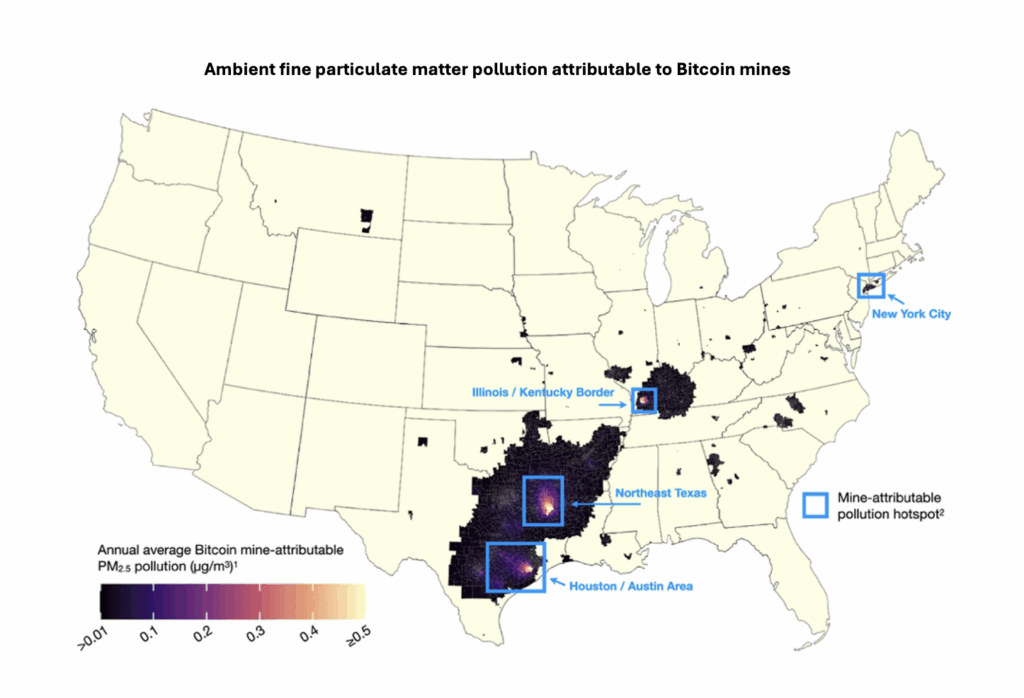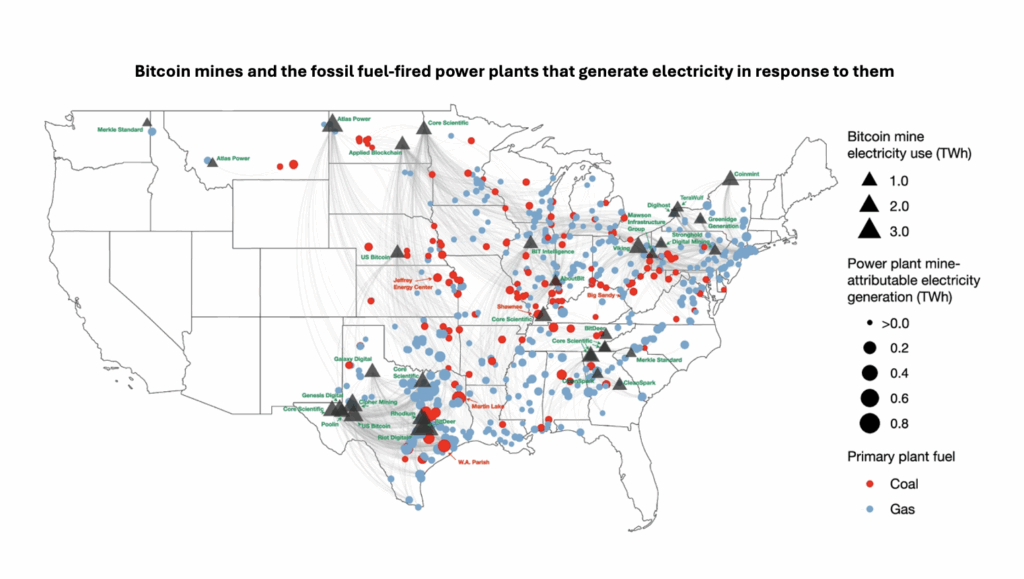Bitcoin’s Toxic Footprint
Bitcoin mining’s rising energy demand in the U.S. drives air pollution and other health risks, with little federal oversight or regulation.

Read Time: 4 minutes
Published:
Cryptocurrencies are digital assets with no physical form. And yet the companies that produce them do so using vast networks of real-world infrastructure and enormous amounts of energy, leaving a trail of environmental damage in their wake.
Bitcoin, the world’s first and most commonly used cryptocurrency, is created through a process called mining, in which powerful computers solve complex mathematical problems to validate transactions and mint new digital coins. The largest Bitcoin mining companies operate out of enormous warehouses, where rows and rows of computers run around the clock. Powering these mines, and keeping them cool, requires a staggering amount of electricity.
For years, Bitcoin was mostly mined in China. However, in 2021, the country banned mining because of the environmental impact, and because the Chinese central bank was testing its own digital currency at the time. In response, many mining operations relocated to the United States, where the share of global Bitcoin mining jumped from 4.5% in 2020 to 38% in 2022. The largest clusters of U.S. Bitcoin mines are in Texas, Georgia, and New York.
This migration has triggered a dramatic rise in electricity demand in the U.S., enough to power millions of homes, and most of that energy comes from burning fossil fuels. The resulting air pollution includes fine particulate matter. Due to its small size, fine particulate matter can penetrate deep into the lungs and bloodstream, which increases the risk of heart disease, respiratory conditions such as asthma, hospitalization, and premature death.
Bitcoin may be virtual, but its impacts are not.
In a new study, Gianluca Guidi and colleagues calculated the amount of power that 34 of the largest Bitcoin mines in the U.S. consumed between mid-2022 and mid-2023. Then they identified which fossil fuel power plants increased output to meet that demand and used atmospheric models to map where the resulting pollution ended up, shown in the Bitcoin-attributable pollution map below.
The Bitcoin mines consumed over 32 terawatt-hours of electricity, more than the entire city of Los Angeles uses each year. Eighty-five percent of that energy came from coal and natural gas. Previous research shows that emissions from some of these power plants contributed to thousands of premature deaths, even before the Bitcoin boom in the U.S.

Nearly 46 million Americans were exposed to elevated levels of fine particulate matter linked directly to Bitcoin mining energy demands. Almost 2 million had particularly high levels of exposure, mostly in New York City, the Houston-Austin corridor, northeast Texas, and the Illinois-Kentucky border. In some neighborhoods, cryptocurrency pollution made up over 10% of the total fine particulate matter exposure.
And the problem is growing. As Bitcoin mining expands and becomes more profitable, it is placing increasing strain on the electric grid. To meet this demand, utility companies are using aging fossil fuel plants for longer, facilities that might otherwise have been retired, which compounds the environmental and health impacts.
The U.S. electric grid is dynamic and adapts to meet fluctuating energy demands. It draws electricity from whichever power plant can meet demand most cheaply or efficiently at a given moment. This means the power plants producing pollution are often located far from the Bitcoin mines they supply—sometimes several states away, as shown in the fossil fuel power plants map below. This creates regulatory challenges. At the federal level, Bitcoin mines are largely unregulated. And when pollution crosses state lines, state and local governments have limited recourse.

In 2024, Arkansas passed laws regulating the energy consumption and noise levels associated with cryptocurrency mining in order to address environmental concerns. But these laws do not protect Arkansas residents from emissions that originate in neighboring Texas, which is known for crypto-friendly policies.
With no clear regulatory authority and oversight fragmented across the states, enforcing air quality standards, transitioning to a cleaner electric grid, and meeting national emissions goals have become more difficult. As the U.S. grapples with air quality and climate goals, cryptocurrency mining demands attention. The study authors highlight the need for federal policies that address the environmental and health costs of energy-intensive digital activity. Bitcoin may be virtual, but its impacts are not.



